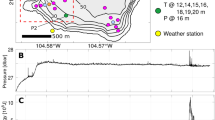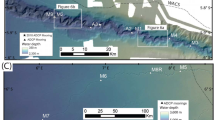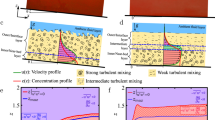Abstract
Earthquakes are commonly cited as one possible triggering mechanism for turbidity flows—dense sediment–water plumes that can transport large volumes of sediment great distances down slope—in both marine and lacustrine settings1,2,3,4,5,6. Heezen and Ewing1 were the first to make such a suggestion, attributing breaks in a sea-floor telephone cable in the North Atlantic Ocean to turbidity flows generated by the 1929 Grand Banks earthquake. Anumber of workers have consequently used sedimentary turbidite records to reconstruct the earthquake histories of various regions2,7,8. Here we present direct observations of a seismically induced turbidity flow. Measurements of light scattering and sediment fluxes in the Cariaco basin indicate that the earthquake that occurred along the coast of northern Venezuela on 9 July 1997 resulted in considerable downslope displacement of sediments—probably >105 tonnes into the deep part of the basin. In such a seismically active region, this mechanism of sediment transport may be responsible for a significant component of the long-term sediment accumulation in the basin. Furthermore, this process may result in the sequestration in deep sea sediments of large amounts of carbon initially deposited at shallow depths.
This is a preview of subscription content, access via your institution
Access options
Subscribe to this journal
Receive 51 print issues and online access
$199.00 per year
only $3.90 per issue
Buy this article
- Purchase on Springer Link
- Instant access to full article PDF
Prices may be subject to local taxes which are calculated during checkout



Similar content being viewed by others
References
Heezen, B. C. & Ewing, M. Turbidity currents and submarine slumps, and the 1929 Grand Banks earthquake. Am. J. Sci. 250, 849–873 (1952).
Inouchi, Y. et al. Turbidites as records of intense paleoearthquakes in Lake Biwa, Japan. Sedim. Geol. 104, 117–125 (1996).
Grantz, A. et al. Character, paleoenvironment, rate of accumulation, and evidence for seismic triggering of Holocene turbidites, Canada Abyssal Plain, Arctic Ocean. Mar. Geol. 133, 51–73 (1996).
Gorsline, D. S. Depositional events in Santa Monica Basin, California Borderland, over the past five centuries. Sedim. Geol. 104, 73–88 (1996).
Thomson, J. & Weaver, P. P. E. An AMS radiocarbon method to determine the emplacement time of recent deep-sea turbidites. Sedim. Geol. 89, 1–7 (1994).
Hughen, K., Overpeck, J. T., Peterson, L. C. & Anderson, R. F. in Palaeoclimatology and Palaeoceanography from Laminated Sediments (ed. Kemp, A. E. S.) 171–183 (Spec. Publ. 116, Geol. Soc. London, (1996).
Adams, J. Paleoseismicity of the Cascadia subduction zone: evidence from turbidites off the Oregon-Washington margin. Tectonics 9, 569–583 (1990).
Doig, R. 2300 yr history of seismicity from silting events in Lake Tadiussac, Quebec. Geology 18, 820–823 (1990).
Spinrad, R. W. Acalibration diagram of specific beam attenuation. J. Geophys. Res. 91, 7761–7764 (1986).
Wakeham, S. G. & Ertel, J. R. Diagenesis of organic matter in suspended particles and sediments in the Cariaco Trench. Org. Geochem. 13, 815–822 (1987).
Wakeham, S. G. Reduction of stenols to stanols in particulate matter at oxic-anoxic boundaries in sea water. Nature 342, 787–790 (1989).
Biscaye, P. E. & Eittreim, S. L. Suspended particulate loads and transports in the nepheloid layer of the abyssal Atlantic Ocean. Mar. Geol. 23, 155–172 (1977).
US Geological Survey, National Earthquake Information Center(cited 25 May 1998) 〈http://www.neic.cr.usgs.gov/〉.
Acknowledgements
We thank the crew of the RV Hermano Gines for their assistance at sea, and W.Gardner, B. Kneller and R. Russo for comments that substantially improved the manuscript. This work was supported by the US NSF and the Venezuelan CONICIT.
Author information
Authors and Affiliations
Corresponding author
Rights and permissions
About this article
Cite this article
Thunell, R., Tappa, E., Varela, R. et al. Increased marine sediment suspension and fluxes following an earthquake. Nature 398, 233–236 (1999). https://doi.org/10.1038/18430
Received:
Accepted:
Issue Date:
DOI: https://doi.org/10.1038/18430
This article is cited by
-
The behaviour of aluminium, manganese, iron, cobalt, and lead in the subarctic Pacific Ocean: boundary scavenging and temporal changes
Journal of Oceanography (2024)
-
Nepheloid layer generation by gas eruption: unexpected experimental results
Journal of Oceanology and Limnology (2023)
-
Accumulation of an earthquake-induced extremely turbid layer in a terminal basin of the Nankai accretionary prism
Earth, Planets and Space (2014)
Comments
By submitting a comment you agree to abide by our Terms and Community Guidelines. If you find something abusive or that does not comply with our terms or guidelines please flag it as inappropriate.



